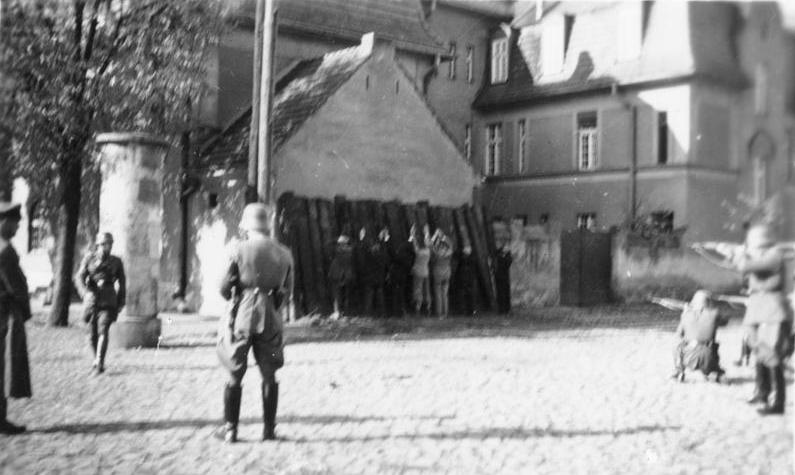The German ‘Sonderfahndungsbuch Polen’ stands for a special investigation book for Poland, known as the proscription book, which included in alphabetical order the names of 61,000 Poles. It was a confidential print, issued by the Criminal Police Office of the Third Reich. Its creation was commissioned by Heinrich Himmler. The list included Polish citizens who posed a threat to “Germanness”, i.e. broadly defined representatives of the Polish elite. Their list became the basis for the mass arrests and murders of the Polish population in the first months of World War II in the territories incorporated into the Third Reich and the General Government.
The list was compiled on the basis of agent work, although this task was not extremely difficult. It was enough to follow the Polish press, both central and local. This was done, for example, by representatives of German diplomatic missions in Poland. Separate, local proscription lists were also kept by members of the Selbstschutz – paramilitary German organisations that became active in the Second Polish Republic. The activity related to the creation of censuses of Poles was fostered by a numerous and active German minority, especially in the west of Poland. In 1939, it was Nazified and eager not only to collect information about Poles, but also to physically fight them.
The preparation of lists went into full swing in April 1939. Despite appearances, however, it was such a large undertaking that work on the unified register dragged on. The Germans were not able to keep up with the data processing. The work was handled by two German offices: the Berlin Gestapo headquarters, and the Zentralstelle II/P (Polen) cell set up in May 1939 in the Main SD Office of the SS Reichsführer. Historians believe that the first list was compiled in September 1939, and then in October of that year, after the German occupation of the Polish territories, a more accurate census was drawn up. It was not completed, as evidenced by the blank pages for each letter of the alphabet. The second version is the “Sonderfahndungsbuch Polen” – “Special book of prosecuted Poles”, which was published in Krakow in 1940.
Poles included in the list were executed, imprisoned in prisons and concentration camps, and deported from the lands annexed to the Third Reich.
During the German occupation, these lists went out under the name ‘Fahndungsnachweis’ (‘Surveillance Diary’). Only a small number of people included on them managed to survive the German occupation. In total, some 80,000 Poles were listed on all of them.
The proscription lists were part of wider German plans for the conquest of Polish lands, known under the code name Operation Tannenberg. Its aim was the annihilation of the Polish leadership and Polish intelligentsia from 1 September 1939, the moment Wehrmacht troops entered Polish territory. Historians regard this enacted criminal plan as the most effective weapon in the extermination of Poles prior to the establishment of concentration and extermination camps.
The operation was carried out not only in the areas incorporated into the Third Reich, but also in the area of the future General Government. It was directed by Reinhard Heydrich, who headed the Reich Security Main Office (RSHA). A special department within the Gestapo for Operation Tannenberg was also created for criminal purposes. Researchers emphasise that, in fact, officers of many services took an active part in Operation Tannenberg.
After the German army attacked Poland, the extermination was carried out mainly by the Einsatzgruppen operational groups. As many as 15 of the 25 Einsatzgruppen and Einsatzkommand commanders had doctorates. They included officers of the Security Police (Sicherheitspolizei – Sipo) and the Party Security Service (Sichercheitsdienst – SD). The Sipo comprised the Gestapo and Kripo, while the SD was SS intelligence and counterintelligence. Recruitment to the Einsatzgruppen was handled by Werner Best – Heydrich’s closest associate.
It was not coincidence that this formation was called the ‘death squadron’. These Germans were trained to kill, and there were some of the greatest criminals of the Second World War among them. For example, members of Einsatzgruppe VI, commanded by SS-Oberführer Erich Naumann, founded and launched the first concentration camp in Poland at Fort VII in Poznań on 10 October 1939 (Sicherheitspolizei. Chef des Einsatzgruppe VI. Konzentrationslager-Posen). Its organiser, and briefly its first commandant, was Herbert Lange, an officer of Einsatzgruppe VI, later commander of the euthanasia operation to murder the mentally ill in the Wartheland and commandant of the German extermination camp Kulmhof in Chełmno on the Ner (approximately 250,000 victims). Like Naumann, the commander of Einsatzgruppe VI, Lange was one of the greatest criminals of the Second World War. He died in 1945.
The findings of historians indicate the following numbers of victims up to 25 October 1939, i.e. the time of the so-called military administration: Reich District of Danzig-West Prussia (30,000), Reich District of Wartheland (10,000), Upper Silesia (2,000), Ciechanów District (1,000), Central Lands – the future General Government (5,000). To these victims one can also add 7 thousand Jews who were killed by Wehrmacht soldiers. In total, during the period in question, about 50 thousand of the most active Poles lost their lives and 750 thousand were deported. To date, we have learned of 760 mass murder sites.
The crimes of Operation Tannenberg were never acknowledged, and the Germans tried to erase their traces even during the war.





